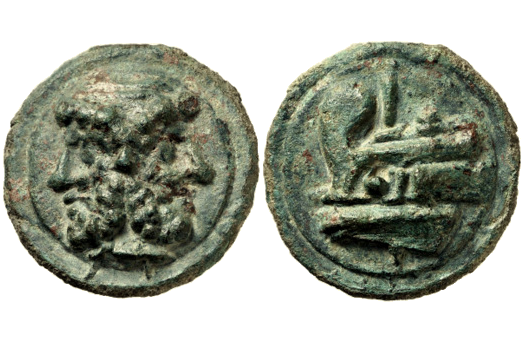
about ancient nomos
Ancient Nomos Art is a museum of galleries exhibiting ancient coins and ancient mint maps. The coin gallery displays the diverse art and history of hand-crafted ancient Greek, Roman, Byzantine, Persian and Medieval coinage. The ancient mints mapping gallery features Greek, Roman, Byzantine, Asia Minor and Medieval mint city regions and territories. Visitor's are welcome to explore, study and enjoy Ancient Nomos Art.

Roman Republic – 217 BC
Aes Grave As
From Ancient Galleries

Obverse: Bronze cast laureate bust of bearded Roman God Janus; all set upon on a raised circular disk.
Reverse: Bronze cast prow of ship galley to the left, mark of value above; all on a raised circular disk.
LEGEND
Obv: Laureate head of bearded Roman God Janus with mark of value below; all on a raised disk. Rev: Prow of ship galley to the left with single pellet on side; I mark of value above.
The above coin is an example of the first Roman coinage made of bronze, aptly named an Aes Grave (“heavy bronze”). The value of the above Aes Grave specimen is known as an As (“unit”), its denomination of value. The ancient Romans began their system of economic exchange by choosing to use bronze as the only coinage metal. The early Roman cast bronze coins are often, at first blush, mistakenly considered cruder and perhaps underdeveloped when compared to the skillfully engraved silver and gold struck coins by their Greek neighbors in Sicily. However, after careful study of these earliest Roman coins, one soon learns that a comparison with Greece is misdirected and lacking in understanding. To fully appreciate the Aes Grave aesthetic, one needs to see the coin as representing an esteemed ancient Roman civic philosophy and as a manifestation or embodiment of Roman confidence, strength, power and practicality. The massive Aes Grave coin represents the symbolic grandeur and pride that was a truly Roman Republic quality. Prior to the Aes Grave coinage, the early fourth century Roman economy exchanged irregular bronze pieces with odd shapes, known as Aes Rude (“rough bronze”). These rough pieces of bronze appeared like fragments of metal and did not depict any official markings, engraved legends, or notations. Toward the end of the fourth century, the Roman system of exchange began producing very large rectangular shaped bronze bars, known as Aes Signatum (“signed bronze”). These large bars of bronze were very heavy (600-2500 grams), and were marked with official notations and symbolic engravings, usually cast into both of its surfaces. By about 280 BC, the Roman exchange system evolved to begin producing their first coin-like bronze pieces (see first cast As coinage). These pieces appeared for the first time as a round or disc-like shape coin and slowly began to supersede the large bronze bars. These early coin-like pieces were cast from circular molds, shaped to look like coins, and were engraved on both sides with symbolic images and official Roman value marks and notations. These disc-like coins are known as Aes Grave (“heavy bronze”), and are also the first Roman coins to cast a mark or notation referencing the specific coin value or denomination, necessary at this time since the exchange rates had exceeded the commodity or intrinsic value of bronze. The city of Rome is credited by many to be the origin of the first casting of the Aes Grave As coins. The largest Aes Grave was the As, which dominated the Roman currency system from about the time of the 1st Punic War through to the start of the 2nd Punic War. These early Roman Aes Grave coins were produced in a wide range of sizes and came in at least seven different denominations. Aside from the rare Decussis (10 Asses) coin, the As unit was generally the largest circulating coin denomination. The Semucia (1/24 As) was a fractional denomination of twenty-four units to an As and was the smallest Roman bronze issued coin at the time. The earliest Aes Grave bronze As coins were intrinsically valued and based by weight on the Libra (one Roman or Attic pound), with a weight of approximately 327 grams. The above Aes Grave coin was issued in Rome during the time of the 2nd Punic War. The Aes Grave obverse depicts a profile bust of the God Janus, bearded and laureate. The entire portrait is engraved on a raised circular disc-like platform. The coin reverse depicts a ship’s prow and partial galley heading left, with a denomination mark “I” cast above and a round pellet in the center. All reverse images are also engraved on a raised circular disc-like platform. By the start of the 2nd Punic War, the Roman Republic was undergoing great economic pressures, coupled with increased inflation and costly expenditures, resulting in a drastic devaluation of bronze. Evidence suggests that the steady diminution of the Aes Grave As weight during the war created a demand for a new exchange system with much higher standards of value. The pressures of war and economic expansion essentially forced the Romans for the first time to convert from a bronze economy to a silver backed economy, thus injecting higher intrinsic value back and greater efficiency into their system of exchange. As a result, Rome for the first time began issuing silver coinage (see silver Janus pre-denarius), with silver as the new base standard of intrinsic value. This change quickly supplanted Aes Grave coinage and virtually stopped the As successive weight reductions. The Roman dependence on a completely bronze based economy was quickly coming to an end. By the war’s end, the Romans successfully transitioned to a bi-metallic economy and slowly began increasing the production of smaller and lighter struck bronze coinage, but this time the coins came with a guaranteed equivalent fraction to the new silver issues. By the end of the 2nd Punic War, Roman cast bronze Aes Grave coinage production would come to a halt and virtually ceased to exist in circulation by the year 213 BC.
DOCUMENTATION
Value: As. Metal: Æ Bronze, “Aes Grave.” Weight: 87.80 grams. One-third libral standard (post semi-libral). Mint: Rome. Date: 217-213 BC.
Attribution: Thurlow-Vecchi 70; Crawford 41/5a; Haeberlin, Ernst: Aes Grave Coinage, plate 49, 1; Sydenham 101.
Legend, Documentation and Attribution
